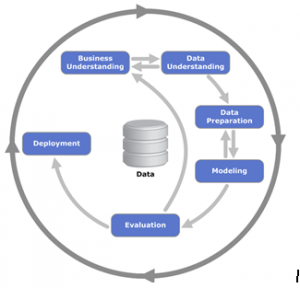CRISP stands for Cross Industry Standard Process. It is a process model that describes commonly used approaches that experts use to tackle problems. Typically, you’ll hear of CRISP in the context of CRISP-DM, defining a process or methodology that breaks the process of data mining into six major phases.
A little more about the CRISP PHASES
The sequence of these phases is not strict, and moving back-and-forth between phases is typical and expected. Certain phases may carry more weight than others and frequent dependencies may exist between some of the phases. In addition, data mining by nature is cyclic – meaning that a data mining process usually continues after a solution has been deployed. Usually lessons learned during this processing will prompt more focused business questions and subsequent efforts will benefit from the experiences of previous ones.
But what about using a CRISP mindset when modeling Cognos TM1 applications? Well, you’ll find that this method of discovery not only “holds true” but works very well.
So let’s take a look at understanding the CRISP Phases and how they relate to TM1 modeling.
Business Understanding
The initial and most fundamental CRISP phase is designed to focus on understanding the objectives and requirements of the business. Obviously, this is also the first critical step in any modeling exercise and no different with TM1. This is usually referred to as “discovery” or (as the process continues) “requirements gathering and documenting”.
Data Understanding
In this phase you perform an initial collection of all of the data perceived to be vital to the solution and then conduct activities designed to become familiar with that data, to identify data quality problems, to discover insights into the data, and detect interesting subsets and form hypotheses for hidden information – again, all exercises absolutely required if you hope to create a useful TM1 model.
Data Preparation
The data preparation phase covers all activities required to construct the final “data pool” (data that will be fed into and used by the model) from the initial raw data sources. Some data preparation tasks may be performed many times, and not in any prescribed order. These tasks may include table/view, record, and attribute selection as well as transformation and cleaning of the data. TM1 models are pretty flexible when it comes to acceptable data formats but every model will require some transformation of source data.
Modeling
In data mining, you would consider which modeling techniques to apply, calibrating parameters to optimal values, analyzing results and, as appropriate, stepping back into the data preparation phase as often as needed. The same approach works well when modeling for TM1. Your data is “organized” into dimensions (with hierarchies and attributes) and (1 or more) cubes, sample data is loaded and as with data mining, you may find that returning to the data understanding and preparation phases may be required.
Evaluation
At this stage, you have put together a model (or models) that you may feel comfortable with, and it is time to thoroughly evaluate the model, review the steps executed to construct the model and make certain it properly achieves the business objectives. In data mining, at the end of this phase, a decision on the use of the data mining results should be reached, with TM1 development of the actual application may begin.
Deployment
Creation of a model is generally not the end; even if the purpose of the modeling exercise was to simply increase knowledge of the data, the knowledge gained will need to be organized and presented in a way that the customer can absorb it. In data mining, a deployment may be as simple as generating a report or as complex as implementing a repeatable mining process. Typically with TM1 the model “prototype” is handed off to a development team for programming, testing and delivery.
Concluding Thoughts
Simply put, CRISP is an industry proven best practice that will be of value to any TM1 modeler.


